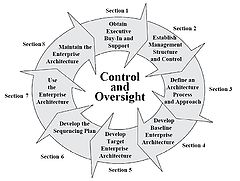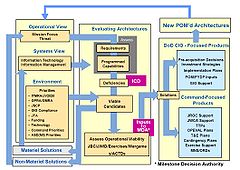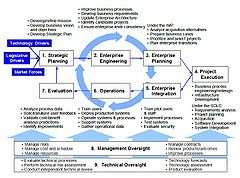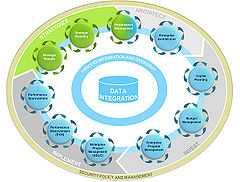
Enterprise Life Cycle
Encyclopedia

Enterprise architecture
An enterprise architecture is a rigorous description of the structure of an enterprise, which comprises enterprise components , the externally visible properties of those components, and the relationships between them...
is the dynamic, iterative process
Business process
A business process or business method is a collection of related, structured activities or tasks that produce a specific service or product for a particular customer or customers...
of changing the enterprise
Business
A business is an organization engaged in the trade of goods, services, or both to consumers. Businesses are predominant in capitalist economies, where most of them are privately owned and administered to earn profit to increase the wealth of their owners. Businesses may also be not-for-profit...
over time by incorporating new business process
Business process
A business process or business method is a collection of related, structured activities or tasks that produce a specific service or product for a particular customer or customers...
es, new technology
Technology
Technology is the making, usage, and knowledge of tools, machines, techniques, crafts, systems or methods of organization in order to solve a problem or perform a specific function. It can also refer to the collection of such tools, machinery, and procedures. The word technology comes ;...
, and new capabilities, as well as maintenance
Software maintenance
Software Maintenance in software engineering is the modification of a software product after delivery to correct faults, to improve performance or other attributes....
, disposition
Disposition
A disposition is a habit, a preparation, a state of readiness, or a tendency to act in a specified way.The terms dispositional belief and occurrent belief refer, in the former case, to a belief that is held in the mind but not currently being considered, and in the latter case, to a belief that is...
and disposal
Disposal
A disposal occurs in Australian rules football when a player either kicks or handballs the football. A disposal is not counted if a player fumbles or illegally disposes the ball...
of existing elements of the enterprise.
Overview
The enterprise life cycle is a concept in Enterprise ArchitectureEnterprise architecture
An enterprise architecture is a rigorous description of the structure of an enterprise, which comprises enterprise components , the externally visible properties of those components, and the relationships between them...
(EA). The Enterprise Architecture process is closely related to other processes, such as enterprise engineering
Enterprise engineering
Enterprise engineering is a subdiscipline of systems engineering, which applies the knowledge and methods of systems engineering to the design of businesses. The discipline examines each aspect of the enterprise, including business processes, information flows, and organizational structure...
and program management cycle, more commonly known as the Systems Development Life Cycle
Systems Development Life Cycle
The systems development life cycle , or software development life cycle in systems engineering, information systems and software engineering, is a process of creating or altering information systems, and the models and methodologies that people use to develop these systems.In software engineering...
. This concept aids in the implementation of an Enterprise Architecture, and the Capital Planning and Investment Control (CPIC) process that selects, controls, and evaluates investments. Overlying these processes are human capital management and information security management. When these processes work together effectively, the enterprise can effectively manage information technology
Information technology
Information technology is the acquisition, processing, storage and dissemination of vocal, pictorial, textual and numerical information by a microelectronics-based combination of computing and telecommunications...
as a strategic resource and business process enabler. When these processes are properly synchronized, systems migrate efficiently from legacy technology environments through evolutionary and incremental developments, and the Agency is able to demonstrate its return on investment. The figure on top illustrates the interaction of the dynamic and interactive cycles as they would occur over time.
Enterprise Architecture Process

Architecture Life Cycle

Operational View
Operational View is one of the basic views, defined in the enterprise architecture of the Department of Defense Architecture Framework V1.5 . Under DODAF 2, which became operational in 2009, the collections of views are now termed 'viewpoints' and no longer views.Other enterprise architecture...
is used to drive the requirements that are evaluated against the Systems View. Operational deficiencies are derived from the analysis, and viable candidates are identified. These candidates can take the form of either materiel or non- materiel solutions and are modeled back into the Operational and Systems Views of the architecture.
The architecture is re-analyzed, and the process continues until the operational deficiencies are minimized. The final sets of viable candidates are assessed for operational viability. Based on the results of the assessments, design changes are made and submitted for inclusion into the budgeting process. This process of developing, analyzing, and modifying continues throughout the architecture’s life cycle.
Enterprise Life Cycle activities

The figure on the right depicts notional activities of an Enterprise Life Cycle methodology. Within the context of this document, Enterprise Life Cycle does not refer to a specific methodology or a specific bureau’s approach. Each organization needs to follow a documented Enterprise Life Cycle methodology appropriate to its size, the complexity of its enterprise, and the scope of its needs.
Enterprise Performance Life Cycle

Enterprise architecture
An enterprise architecture is a rigorous description of the structure of an enterprise, which comprises enterprise components , the externally visible properties of those components, and the relationships between them...
in the center of the EPLC conceptual diagram, shown in the figure, reflects the supporting and enabling role that enterprise architecture serves for the major business functions in the Enterprise Performance Life Cycle.
The Enterprise Architecture
Enterprise architecture
An enterprise architecture is a rigorous description of the structure of an enterprise, which comprises enterprise components , the externally visible properties of those components, and the relationships between them...
(EA) Program explicitly considers the information needs of the Enterprise Performance Life Cycle (EPLC) processes in developing and enhancing the EA Framework, collecting and populating data in the EA Repository, and developing views, reports, and analytical tools that can be used to facilitate the execution of the EPLC processes. The EPLC conceptual diagram in the figure provides a Departmental perspective of key business functions. The EPLC is also relevant from an individual investment or project perspective, as each new investment passes through each phase of the EPLC. The investment-level perspective is detailed in the an Enterprise Performance Life Cycle Framework.
See also
- Business analysisBusiness AnalysisBusiness analysis is the discipline of identifying business needs and determining solutions to business problems. Solutions often include a systems development component, but may also consist of process improvement, organizational change or strategic planning and policy development...
- Enterprise Architecture PlanningEnterprise Architecture PlanningEnterprise Architecture Planning in Enterprise Architecture is the planning process of defining architectures for the use of information in support of the business and the plan for implementing those architectures.- Overview :...
- Enterprise modeling
- Product lifecycle managementProduct lifecycle managementIn industry, product lifecycle management is the process of managing the entire lifecycle of a product from its conception, through design and manufacture, to service and disposal...
- Service-oriented modeling life cycle
- Software Lifecycle Processes
- Systems Development Life CycleSystems Development Life CycleThe systems development life cycle , or software development life cycle in systems engineering, information systems and software engineering, is a process of creating or altering information systems, and the models and methodologies that people use to develop these systems.In software engineering...
- Technology Life Cycle
- Whole-life costWhole-life costWhole-life cost, or Life-cycle cost , refers to the total cost of ownership over the life of an asset . Also commonly referred to as "cradle to grave" or "womb to tomb" costs. Costs considered include the financial cost which is relatively simple to calculate and also the environmental and...
Further reading
- Alain Bernard, Serge Tichkiewitch (2008). Methods and Tools for Effective Knowledge Life-Cycle-Management.
- Peter BernusPeter BernusPeter Bernus is an Hungarian Australian scientist and Associate Professor of Enterprise Architecture at the School of Information and Communication Technology, Griffith University, Brisbane, Australia.- Biography :...
, Laszlo Nemes, Günter Schmidt (2003). Handbook on Enterprise Architecture. - Jeffrey O. Grady (2006). System requirements analysis
- Arturo Molina, Jose Manuel Sanchez, Andrew Kusiak (1998). Handbook of Life Cycle Engineering: Concepts, Models, and Technologies.
- François VernadatFrançois VernadatFrançois B. Vernadat is a French and Canadian computer scientist, who has contributed to Enterprise Modelling, Integration and Networking over the last 25 years specialising in enterprise architectures, business process modelling, information systems design and analysis, systems integration and...
(1996). Enterprise Modeling and Integration: Principles and Applications.
External links
- Enterprise Life Cycle Management presentation 2005
- EA in the Federal Enterprise Life Cycle EA in the Federal Enterprise Life Cycle presentation 2006.

